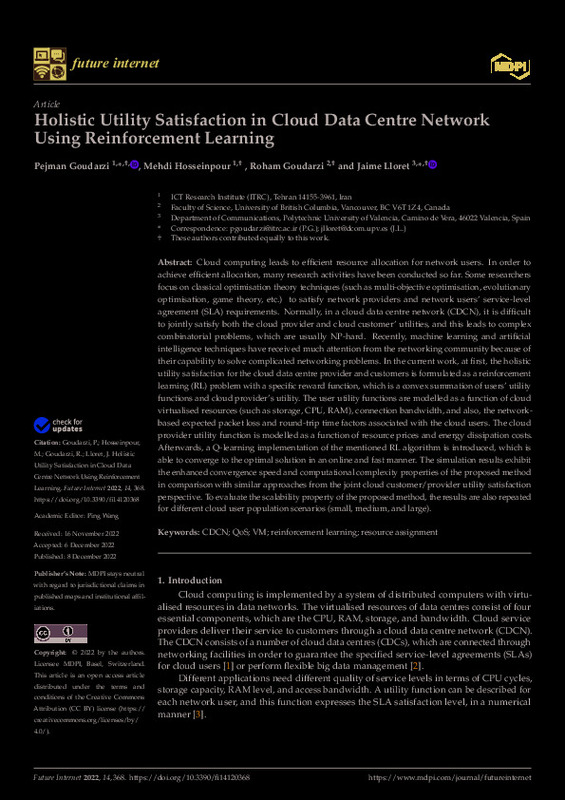JavaScript is disabled for your browser. Some features of this site may not work without it.
Buscar en RiuNet
Listar
Mi cuenta
Estadísticas
Ayuda RiuNet
Admin. UPV
Holistic Utility Satisfaction in Cloud Data Centre Network Using Reinforcement Learning
Mostrar el registro sencillo del ítem
Ficheros en el ítem
| dc.contributor.author | Goudarzi, Pejman
|
es_ES |
| dc.contributor.author | Hosseinpour, Mehdi
|
es_ES |
| dc.contributor.author | Goudarzi, Roham
|
es_ES |
| dc.contributor.author | Lloret, Jaime
|
es_ES |
| dc.date.accessioned | 2023-12-11T19:01:03Z | |
| dc.date.available | 2023-12-11T19:01:03Z | |
| dc.date.issued | 2022-12 | es_ES |
| dc.identifier.uri | http://hdl.handle.net/10251/200619 | |
| dc.description.abstract | [EN] Cloud computing leads to efficient resource allocation for network users. In order to achieve efficient allocation, many research activities have been conducted so far. Some researchers focus on classical optimisation theory techniques (such as multi-objective optimisation, evolutionary optimisation, game theory, etc.) to satisfy network providers and network users¿ service-level agreement (SLA) requirements. Normally, in a cloud data centre network (CDCN), it is difficult to jointly satisfy both the cloud provider and cloud customer¿ utilities, and this leads to complex combinatorial problems, which are usually NP-hard. Recently, machine learning and artificial intelligence techniques have received much attention from the networking community because of their capability to solve complicated networking problems. In the current work, at first, the holistic utility satisfaction for the cloud data centre provider and customers is formulated as a reinforcement learning (RL) problem with a specific reward function, which is a convex summation of users¿ utility functions and cloud provider¿s utility. The user utility functions are modelled as a function of cloud virtualised resources (such as storage, CPU, RAM), connection bandwidth, and also, the network-based expected packet loss and round-trip time factors associated with the cloud users. The cloud provider utility function is modelled as a function of resource prices and energy dissipation costs. Afterwards, a Q-learning implementation of the mentioned RL algorithm is introduced, which is able to converge to the optimal solution in an online and fast manner. The simulation results exhibit the enhanced convergence speed and computational complexity properties of the proposed method in comparison with similar approaches from the joint cloud customer/provider utility satisfaction perspective. To evaluate the scalability property of the proposed method, the results are also repeated for different cloud user population scenarios (small, medium, and large). | es_ES |
| dc.description.sponsorship | We would like to express our gratitude to ITRC and UPV for their joint support of this research. | es_ES |
| dc.language | Inglés | es_ES |
| dc.publisher | MDPI AG | es_ES |
| dc.relation.ispartof | Future Internet | es_ES |
| dc.rights | Reconocimiento (by) | es_ES |
| dc.subject | CDCN | es_ES |
| dc.subject | QoS | es_ES |
| dc.subject | VM | es_ES |
| dc.subject | Reinforcement learning | es_ES |
| dc.subject | Resource assignment | es_ES |
| dc.subject.classification | INGENIERÍA TELEMÁTICA | es_ES |
| dc.title | Holistic Utility Satisfaction in Cloud Data Centre Network Using Reinforcement Learning | es_ES |
| dc.type | Artículo | es_ES |
| dc.identifier.doi | 10.3390/fi14120368 | es_ES |
| dc.rights.accessRights | Abierto | es_ES |
| dc.contributor.affiliation | Universitat Politècnica de València. Escuela Politécnica Superior de Gandia - Escola Politècnica Superior de Gandia | es_ES |
| dc.description.bibliographicCitation | Goudarzi, P.; Hosseinpour, M.; Goudarzi, R.; Lloret, J. (2022). Holistic Utility Satisfaction in Cloud Data Centre Network Using Reinforcement Learning. Future Internet. 14(12):1-21. https://doi.org/10.3390/fi14120368 | es_ES |
| dc.description.accrualMethod | S | es_ES |
| dc.relation.publisherversion | https://doi.org/10.3390/fi14120368 | es_ES |
| dc.description.upvformatpinicio | 1 | es_ES |
| dc.description.upvformatpfin | 21 | es_ES |
| dc.type.version | info:eu-repo/semantics/publishedVersion | es_ES |
| dc.description.volume | 14 | es_ES |
| dc.description.issue | 12 | es_ES |
| dc.identifier.eissn | 1999-5903 | es_ES |
| dc.relation.pasarela | S\491793 | es_ES |








